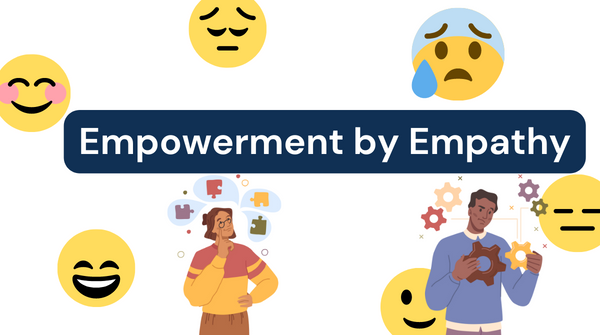Empowerment by Empathy

True service is not done from a position of weakness, since it takes a person with power to empower.
The Bureau of Labor Statistics reported that on the last business day of April 2023, “the number of job openings edged up to 10.1 million.” The takeaway for fast-growing SMBs is that we can’t count on being able to hire qualified people; we have to develop them.
At its essence, bringing out the potential in people is a service to them. Paradoxically, the aim of serving is to get people to the point that they don’t need you. That’s when they begin to feel their value within the organization. When you have the mindset that your role is to serve the people working for you, you empower them.
It sounds strange, but there should be a person at the top level involved with trainees. Not, perhaps, as their principal mentor, but involved enough to observe their tendencies during a variety of interactions and as they carry out various tasks. That way, the top person can mentor their mentor with insight. This takes a visionary, one who can identify innate characteristics because they can’t help but notice patterns of behavior, both positive and negative.
Ask Yourself: Am I Empathetic?
But what if your strong suit is not picking up on what makes people tick?
The real question here is, how can you recognize potential? For example, in the tech arena, the CTO or chief developer should be looking for who has what it takes to grow into a developer, a systems admin, an SEO specialist, a QA person, and so on—all the needs of the company that you can see coming down the line.
To recognize who would be good at what, cultivate your empathy.
Did you catch that? Empathy is a learned skill. If you weren’t taught it somewhere along the line, you can start now.
Research has shown that empathy is partly innate and partly learned. Psychologists suggest many ways to strengthen your empathy. Here are eight of them:
- Challenge yourself. Undertake challenging experiences that push you outside your comfort zone… Doing things like this will humble you, and humility is a key enabler of empathy.
- Get out of your usual environment. Travel, especially to new places and cultures. It gives you a better appreciation for others.
- Get feedback. Ask for feedback about your relationship skills (e.g., listening) from family, friends, and colleagues—and then check in with them periodically to see how you’re doing.
- Explore the heart, not just the head. Read literature that explores personal relationships and emotions.
- Walk in others’ shoes. Talk to others about what it is like to walk in their shoes—about their issues and concerns and how they perceived experiences you both shared.
- Examine your biases. We all have hidden (and sometimes not-so-hidden) biases that interfere with our ability to listen and empathize… Don’t think you have any biases? Think again—we all do.
- Cultivate your sense of curiosity. What can you learn from a very young colleague who is “inexperienced?” What can you learn from a client you view as “narrow”? Curious people ask lots of questions (point 8), leading them to develop a stronger understanding of the people around them.
- Ask better questions. Bring three or four thoughtful, even provocative questions to every conversation you have with clients or colleagues.
Delve more into this topic with websites like: How to Develop Empathy: 10 Exercises & Worksheets
Some Things, You Just Gotta Uproot
As I write this, I have to look at how well I’m doing in this area. After all, I don’t want to be a hypocrite, and for some who are reading this, empathy is one of your strengths (help the rest of us—post your insights in the Comments section!). Reading up on how to develop empathy has led to some soul-searching to find out where I’m lacking and, most important, why. What’s the root of it that has to be dug out if the articles I read on empathy are going to do me any good?
Same thing applies to the people you employ: Most people probably come into your organization accustomed to environments where everybody is focused on getting and not giving. It will take a while before they believe your group is different. Give them time to root out old ways of thinking, and most people will flourish.
But remove the diehard takers, those who continue to be self-serving, who have repeatedly shown that they don’t have the team’s best interests in mind.
Does that sound ruthless? It isn’t if your heart is in the right place.
If you care about the person and not just what they are accomplishing within your organization, you will do what’s best for them.
Let me state it another way: Never confuse enabling with serving. It is a disservice to anyone to let them keep going the way of a taker. I know, it’s hard to get rid of a skilled person just because of their attitude, but how else will you protect the ones you have worked so hard to teach that the wisest way is for each one to focus on how to serve all the others?
"Do you want to be counted wise, to build a reputation for wisdom? Here’s what you do: Live well, live wisely, live humbly. It’s the way you live, not the way you talk, that counts. Mean-spirited ambition isn’t wisdom… It’s the furthest thing from wisdom—it’s animal cunning, devilish conniving. Whenever you’re trying to look better than others or get the better of others, things fall apart and everyone ends up at the others’ throats." – Eugene H. Peterson
Some Ways to Discover Potential
Back to the topic of a top-level person finding the potential in trainees. This is what is working for me as a CTO:
I interact frequently with the trainee at first, to set them in the path that the organization is on. Later, it is more effective to let them go for a while and only meet at intervals with them and their mentor. (I make sure the person they report to has the heart of a mentor and is not just a trainer, meaning they have taken to heart the concepts above. Enough said.)
The end of a project is an opportunity to look for patterns in work habits. Look for personality traits like curiosity (the tenacious researcher), creativity (the born troubleshooter), and patience (the natural customer service rep).
Empathy leads to the discovery that every character “flaw” is just the flip side of a strength. The law-and-order person who sees everything as black and white? Probably also organized and punctual. Use them to help others stay on track. Disorganized? Most likely also a freeform, creative thinker who comes up with new and better ways to do things.
Reflect on your own traits and those of the principals in your company so you can more readily spot those characteristics in trainees. Then consider how the newcomers can use their strengths to fill in the gaps for others. You can’t talk enough about appreciating the differences in each other and the importance of a varied and balanced team if you want to replace judging with empathy throughout your organization—and it doesn’t hurt to remind yourself too.
A caution here…
Once you pattern a weakness, that doesn’t mean you should keep the person from any activity they will have to struggle with, and only play to their strengths. They need some exposure to their areas of weakness—with guidance—so they can improve in those areas.
The Nitty-Gritty
Of course, there are the nuts and bolts to assess too. How well did they understand the task? Did they set up for it well?
Listen for any frustration because they can’t get something done, and figure out what is lacking: clear specs, a communication chain linked to the decision makers, good tools. (This goes for all personnel, not just new hires.)
Powerful tools are expensive, but people are more so, and in more ways than just their salary.
Everyone in an SMB must be a self-learner. To find out if they have taken the time to know the tools, I ask if they are using specific features.
If I get a blank look, I tell them the story from yesteryear about a son who grew up felling trees with his dad with a two-man crosscut saw. After he moved away from home and went out on his own, he bought his father a chainsaw, saying “Dad, you’re going to love this new invention! It’ll make cutting down trees without me way faster than we ever did it together.” After a few weeks, the son was visiting his dad again and asked how he liked the new tool. His father said, “Son, I can’t make any headway with this thing. It’s faster with an ax.” The son said, “Let me see what’s wrong with it, Dad.” He yanked the pull cord, and the saw sprang to life. His dad hollered, “Holy smoke! What’s that noise?!”
Then I ask, “So, are you going to start your chainsaw?”

